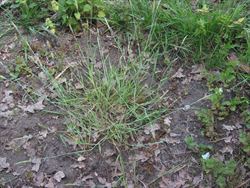Click on images to enlarge

James Lindsey at Ecology of Commanster [CC-BY-SA-2.5 (http://creativecommons.org/licenses/by-sa/2.5) or CC-BY-SA-3.0 (http://creativecommons.org/licenses/by-sa/3.0)], via Wikimedia Commons

Photo by: (nl: Geknikte vossestaart plant) (Alopecurus geniculatus inflorescens; Wikipedia.org

Photo by: (nl: Geknikte vossestaart plant) (Alopecurus geniculatus inflorescens; Wikipedia.org

Photo by: (nl: Geknikte vossestaart tongetje) Alopecurus geniculatus ligula - Wikipedia.org
Scientific Name
Alopecurus geniculatus L.
Synonyms
Alopecurus australis Nees
Family
Gramineae (South Australia)Poaceae (Queensland, New South Wales, the ACT, Victoria, Tasmania, Western Australia and the Northern Territory)
Common Names
foxtail, foxtail grass, marsh fox-tail, marsh foxtail, water foxtail
Origin
Native to north-western Africa (i.e. Algeria and Morocco), Europe and the Indian sub-continent (i.e. India and Nepal). Possibly also native to some parts of North America (i.e. southern Alaska, Canada and the northern and western parts of the USA).
Naturalised Distribution
Widely naturalised in the temperate and semi-arid regions of southern and central Australia. It is most common and widespread in Victoria, Tasmania, the eastern and southern parts of South Australia and the inland regions of New South Wales. Also present in inland southern Queensland, eastern New South Wales, some inland parts of southern Western Australia and other parts of South Australia.
Notes
Marsh foxtail (Alopecurus geniculatus) is regarded as an environmental weed in Victoria and Western Australia. This species often grows as a weed of damp or wet areas (i.e. waterways and wetlands) in inland regions.
It is of most concern in Victoria, where it is thought to pose a threat to one or more vegetation formations. Marsh foxtail (Alopecurus geniculatus) is listed as a high threat weed species in calcareous wet herbland vegetation in the Glenelg Plain bioregion. It also appears on some environmental weed lists in this state (i.e. in Knox City and the Goulburn Broken Catchment) and has been recorded in the Barkindji Biosphere Reserve, in north-western Victoria.
Though not yet common or widespread in Western Australia, it is a weed of woodland areas in the goldfields region and was given a mild rating in the Environmental Weed Strategy of Western Australia. It has also been recorded in Kinchega National Park in south-western New South Wales and is associated with permanently or temporarily wet sites (e.g. river red gum flats) in South Australia.

